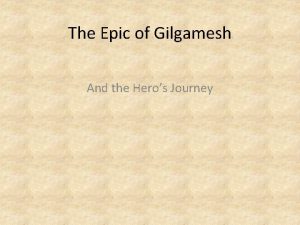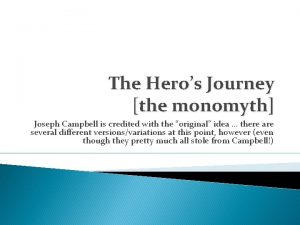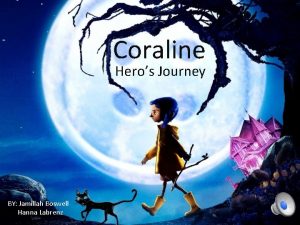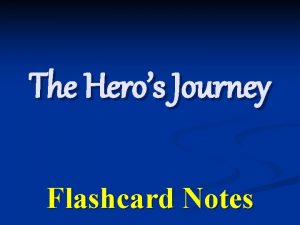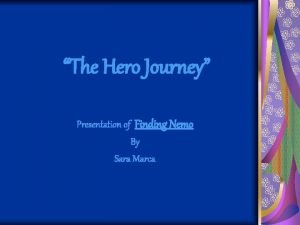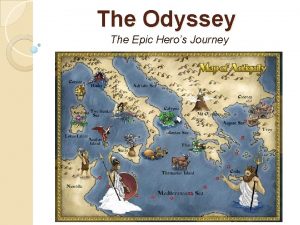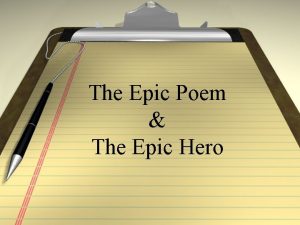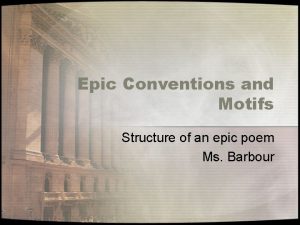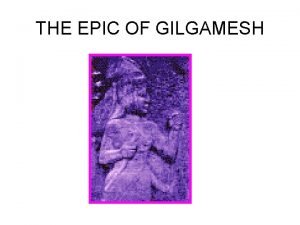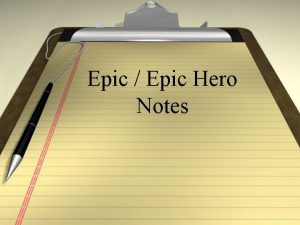The Epic of Gilgamesh And the Heros Journey











- Slides: 11

The Epic of Gilgamesh And the Hero’s Journey

What is the Hero’s Journey? • The Hero’s Journey, according to Joseph Cambell is a frequently occurring story archetype. • Many, if not most stories from all over the world, fit at least partially into this pattern.

Steps of the Hero’s Journey • There are three basic steps: The Departure, the Initiation, and the Return. • These are divided into 17 substeps, listed on the right. • Most stories do not have all 17 steps. 1. 2. 3. 4. 5. 6. 7. 8. The Call to Adventure Refusal of the Call Supernatural Aid Crossing the 1 st Threshold The Belly of the Whale The Road of Trials The Meeting with the Goddess Temptation away from the true path. 9. Atonement with the Father 10. Apotheosis 11. The ultimate boon 12. Refusal of the Return 13. The Magic Flight 14. Rescue from Without 15. Crossing the Return Threshold 16. Master of the 2 Worlds. 17. Freedom to Live.


About ancient Mesopotamia • Around the 8 th millennium BCE, small farming communities arose in the Fertile Crescent, particularly in an area of it located between the Tigris and Euphrates rivers. • Roughly 4000 years later, societies developed from these communities in the form of city-states. They developed (relatively) sophisticated political structures and created irrigation systems. • Eventually, empires formed under the rule of “God kings. ” Assyria, Babylon are • However, the times were violent and brutal. The dams and dikes could not protect against strong floods or droughts, and war with barbarians or other city-states was a simple fact of life. • The religions reflected this reality: The Gods were harsh and amoral, and the afterlife was a grim, hopeless place.

About Gilgamesh • One king, Gilgamesh of Uruk, would become a legend. • According to the stories, he was 67 percent God. • A powerful man, he was exceptionally strong and also good-looking. • However, his semi-divine nature made him arrogant and impulsive. • He also did not understand the concept of death and spent a significant amount of time trying to conquer it, as he was still mortal.

Enkidu • Gilgamesh ruled his city, Uruk, with an iron fist. So, the gods made the wild man, Enkidu. He was tasked with harassing Gilgamesh and keeping him too busy to be oppressive. • However, Gilgamesh “civilized” Enkidu by sending a prostitute to have sex with him. Shortly afterwards, Gilgamesh and Enkidu fought each other. The former prevailed, but grew respect for the latter, and the two became friends. • Enkidu is the “voice of reason. ” He tries to talk sense into his more impulsive friend.

Introduction to the story. • Gilgamesh is one example of a hero’s journey. • Like many epics, the story begins with the narrator summarizing the story. • The narrator says that Gilgamesh had been explored all of the known world on his quest for knowledge. • He was built to perfection by the gods. • In addition, his feats – the walls of Uruk – are still here “today. ”

About Humbaba • Humbaba is the guardian of the Lebanese forests. • Physically, he is a giant ogre who has a face made of intestines. • Specifically, he guards seven flames, or “splendors” as they are called. • Despite being a monster and antagonist, he actually works for the gods. • In addition, he has a house and employs servants.

The Battle with Humbaba • Gilgamesh and Enkidu set out to kill Humbaba and take his wood. • Upon Encountering the ogre, Gilgamesh pray’s to Shamash for help. • Shamash responds by paralyzing Humbaba with wind. • Gilgamesh and Enkidu set out to put out the seven splendors before Humbaba’s servants can return with weapons. • When all but one fire is out, Humbaba begs for mercy. • Gilgamesh considers sparing Humbaba, but Enkidu tells him otherwise. They then kill Humbaba. • With the guardian gone, the pair proceeds to deforest the area.

The Death of Enkidu • Some time later, Ishtar approaches Gilgamesh and asks him to be her consort. • Gilgamesh rejects her, pointing out that she is an abusive lover. • Angered, Ishtar sends a giant bull to kill Gilgamesh and Enkidu. This fails, with the pair killing the bull. • Angered further, Ishtar makes Enkidu fall ill. • While he is sick, he tells Gilgamesh about his dreams about death and the (extremely grim) afterlife. • These were prophecies. Enkidu dies shortly afterwards.
 What are the seven splendors of humbaba
What are the seven splendors of humbaba Glove and boots heros journey
Glove and boots heros journey Mulan heroes journey
Mulan heroes journey Hero's journey coraline
Hero's journey coraline Heros journey notes
Heros journey notes Finding nemo journey
Finding nemo journey Hero's journey captain america
Hero's journey captain america Heroes in epics
Heroes in epics Odyssey map of odysseus journey
Odyssey map of odysseus journey Epic definition
Epic definition Edgenuity epic poetry gilgamesh answers
Edgenuity epic poetry gilgamesh answers Conventions of epic poetry
Conventions of epic poetry
